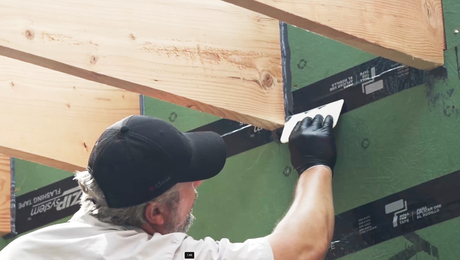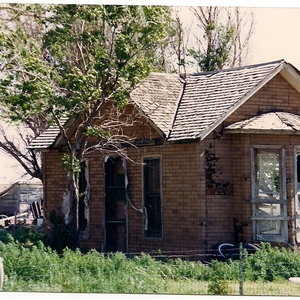condensation problem under insullation around AC/heat duct
I live in eastern Maryland and own a heat pump that has an air handler in the attic and one in the crawl space. The heat pump is for both AC and heat. Now, in the summer, I have a big condensation problem underneath the foil insulation wrapped around the square sheet metal “cool” ducts attached to my air handler in the attic. There is so much water between the insullation and the duct that it has found it’s way out and is dripping on and through my ceiling drywall.
To address this problem, should I remove the insullation permanently (which might cause problems in the winter when the cool duct is carrying heated air? Or should I replace the foil insullation with something else? If so, what product would you recommend? Or should I replace the insullation and install some sort of drain by inserting a tube in the insullation and then putting the other end of the tube out the soffet to drain?
– Lyptus


















Replies
You have cold metal in an attic that is probably 140 degrees and loaded with humid air. Ditch the attic unit and go with mini splits. You may be able to ditch the metal ducts and switch to fiberglass ducts but I am leary of them blowing fibers which can possibly cause cancer. Fiberglass ducts shouldn't have a condensation problem even in an attic.
Part of the problem may be leaky ducts, especially the return ducts. If warm, moist air from the attic is being sucked into contact with the cooler returns, there will be condensation between the insulation and the duct surface.
quick fix
Eventually I plan to replace the attic unit and ducts but in the meantime while I'm saving up the $1000's, what should I do to stop the leak and minimize it's reoccurance?
Thanks,
Lyptus
Peel off the insulation and seal all the joints and seams in the ductwork, preferably with mastic you buy specially for the purpose. Don't use duct tape unless it is labeled to meet UL 181 standards. Then re-apply the insulation and seal the joints and tears in the foil skin with foil tape. Take care not to compress the fiberglass--compressed, it is nearly useless as a barrier to heat transfer.
What would
the other part(s) be?
Tightly seal the insulation so no humid air can get in under the insulation.
How does sealing the insulation tightly make it "so humid air can get in under the insulation."?
How does sealing the insulation tightly make it "so humid air can get in under the insulation."?
I didn't say it did. I said:
Tightly seal the insulation so no humid air can get in under the insulation.
I misread ... wow ... thought I read it twice, too. Go figure. Guess my brain in english class wasn't full after all!!
Remove the insulation wrap and spray foam it. Coat all of the ducts that are above/outside the thermal envelope of the home. This will seal the duct work and ultimately give it the thermal break it needs to stop the condensation not to mention increase the efficiency of the distribution system.
For health and safety measures, assuming that the attic is not adequately vented, I would leave the AC/Heat off for a 24-48 hour period to let the foam fully cure. Especially if there are some obvious leaks in the system.
3" of 2 lb. Closed Cell Foam oughta do it!
If it is a small job have the insulation contractor also quote you for doing the rim joist in your basement along with this. It might make his day a bit more worthwhile and keep the price reasonable.
I typed your comment yesterday and never posted it. The issue is the cold metal in the hot MOIST environment. You either have to get rid of the cold metal ergo my suggestion of mini split systems or switching to fiberglass ducting or you have to find a way to total and completely isolate the cold metal from the warm air. Spray foam should fit the bill.
Sealing the ducts is a matter of efficiency not condensation control. The thing I wrestle with is the air handler itself is going to be cold enough to condense water too and that is going to be a horse of an entirely different color since it will be hard to completely seal that off from outside air. Hopefully, the air handler is sitting on a drain pan of some sort.
Switching to the fiberglass main duct may still be the most economical way to go given the cost of spray foam but you can get DIY spray foam kits and as long as you can spary all sides, that should stop it. It shouldn't take much. You can put ice water in a 1/8 inch foam cup and it won't condense water.
I agree that sprayed foam is the best solution, if that's possible/reasonable--it will seal the ducts and prevent condenstation.
However, I have a hard time imagining that leaks in foil insulation alone would allow enough attic air to come in contact with the cold ducts so that he would experience the extreme level of condensation he's describing. I think air movement due to leaky ducts must be involved.
Return leaks will definitely bring moist air in contact with cool metal, but there may be very little in the way of return ductwork in the attic, or there may be a lot--he doesn't say.
Leaks on the supply ducts can add to the problem by causing the attic return(s) to "suck" harder. Any return leaks there would be worsened.by loss of supply air.
If the insulation is just sort of laying there, with no seal at the joints, lots of air can get in and cause condensation. The dewpoint was 82F here a couple of days ago and I have to imagine that points east have seen worse. Doesn't take much of that air leaking for the ductwork to be sweating like a fat guy in a steam bath.
Return air leaks wouldn't be a factor because the return air ductwork remains at ambient temp until it comes within inches of the air handler -- no "cool metal" for the air to contact.
Return duct temp will start out at room temp and if uninsulated get warmer. Not sure what you mean when it gets within inches of the AHU ... then what? Seems like that will be the warmest it will get ... just before going into the cooling coil.
Relatively speaking, the start of the return air will be fairly cool (say 80 deg) compared to the high RH and temp in the attic (say 120 deg and 60% RH.
But the return air temp is nowhere near as cool as the supply air.
say 120 deg and 60% RH.
That's pretty humid -- 102F dewpoint. For condensation to occur the surface must be below the dewpoint. Dewpoints above 80 are certainly not unheard of (had them here a few days ago) but they're pretty unusual.
That' pretty bad
when DanH catches your fictions!
Dan H is right on. Your problem is the warm/hot moist attic air coming into contact with the cold ducts. Your vapor retarder is not very good. The vapor retarder should be on the outside of the insulation and prevent the warm air from getting through.
Either seal the vapor retarder up better or switch insulation.
I disagree w/ the suggestions to seal the ducts better. If air is leaking out of the ducts, it is cool and dry. It isn't the source of condensation IMO. The RETURN duct may be a different issue as it is sucking any air leakage from the attic. But I'm guessing you don't have much if any return ductwork.
Everyone is assuming
the moisure is due to condensation of the attic air on the cool supply duct. This happens, but to not to a degree that will cause significant wetting of the insulation on the duct or under the duct. Is the top of the duct and insulation wet? Probably not, and this would eliminate the condensation on the duct as the source of the water.
Certainly check the integrity of the supply duct and the wrap around it. I suspect the source of the moisture is what is called "carryover" due to a clogged drain, a partially clogged coil or both. Water that condenses on the cooling/heating coil is getting blown down the duct by the fan because its not properly draining from the unit. The ductwork is not water tight and it leaks out, soaks the insulation and everything beneath it.
If the drain is clogged and there is no overflow switch, the water will just continue coming off of the coil and puddle in the bottom of the unit and the supply duct (check the bottom of the inside of the unit as well, its probably soaking wet). A partially blocked coil could cause the velocity through the free area of the coil to increase to the point that the water condensing on the coil will get blown off and downsteam and not collected in the drain pan. This is pretty unlikely, though.
Has there been any changes to your system just before you noticed this problem? Has it always done this, every year? Last year?
You bring up a good point about the drain pan in the AHU itself. A common problem. We assumed it didn't have to do w/ that because of how the OP stated his condition.
If the OP is in a humid climate, you could see significant collection of condensation on the supply duct. That duct is COLD relative to the warm humid attic conditions. That condensation is going to run down the face of the sheet metal and collect, drip, and soak the insulation ... and then drip some more and destroy his ceilings.
But collection of water on the ceiling at one point doesn't mean that's where the problem on the duct is. Much like roof leaks, it can be a bit ellusive as to the point source ... which as you say could be at the AHU ... and I agree ... at least double check the drain line on the AHU for a plugged drain ... one of the most common problems that occurs.
As another poster pointed out ... double check your drain pan on the AHU. It's common for the line to plug and the pan to fill up and overflow. Are you sure that's not the source of your 'leak'?